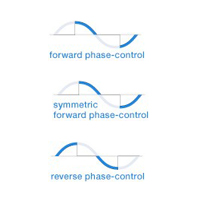 Can I dim LED? Was the most frequently asked question in 2014. For the most part the answer is yes, but first you must do your research. Every manufacturer’s LED array (light emitting diodes mounted in an array on a circuit board) or LED light bulb may have different dimming requirements.
Can I dim LED? Was the most frequently asked question in 2014. For the most part the answer is yes, but first you must do your research. Every manufacturer’s LED array (light emitting diodes mounted in an array on a circuit board) or LED light bulb may have different dimming requirements.
Most (but not all) screw-in LED light bulbs are compatible with standard incandescent dimmers. Compatible means that the bulbs can be dimmed, although the bulb’s dimming performance may not match what you’re used to seeing when dimming an incandescent or halogen bulbs. Depending on the quality of the bulb you select, compatible bulbs may still:
– have less dimming range than an incandescent or halogen bulb
– dim less smoothly than an incandescent or halogen bulb
– flicker or shimmer at certain light levels
– buzz
Let’s review some dimming basics:
Line-voltage (120V) incandescent and halogen lamps use forward phase-control dimming. Resistive – rated for cold filament inrush, the positive and negative periods may not be equal. The lamp is energized only during the last portion of each power-line half cycle. Forward phase dimming uses robust electronics, is suitable for most loads, including incandescent, tungsten halogen, as well as some types of LED power supplies.
Magnetic low voltage lighting transformers (MLV) use symmetric forward phase-control dimming. Inductive – symmetric cycles, the positive and negative periods are equal. MLV dimmers are required for all low-voltage lighting using magnetic low-voltage transformers regardless if the lamp is halogen or LED.
Electronic low voltage lighting transformers (ELV) use reverse phase-control dimming. Capacitive – the lamp is energized during the initial portion of each power-line half cycle. Reverse phase dimming uses more complex electronics (solid state). ELV dimmers are required for all low-voltage lighting using electronic low-voltage transformers regardless if the lamp is halogen or LED.
LED (Light Emitting Diode) & Electronic LED Drivers. All LEDs (arrays and lamps) require drivers to operate. LED drivers work similar to low-voltage transformers. The LED light source must be matched to the LED driver and every manufacturer will differ. Some LED fixtures have the LED driver built-in as an integral part of the fixture, others supply a remote mounted driver, and LED lamps have the driver built into the base of the lamp.
Dimmers are designed to send power and control signals to the LED driver. This is where you must do your research, especially if you are using more than one type of LED on a circuit. Check the recommendations of the manufacturer; check both the LED/Driver and the Dimmer specifications. Some LED drivers use incandescent (forward phase), some use MLV (symmetric forward phase), some use ELV (reverse phase) and some use 0-10V dimmers.
Ok…we threw you a loop on that last one, 0-10V dimming, we have not discussed that yet. 0-10V is an analog lighting control protocol; applies a voltage between 0V and 10V to produce varying intensity levels. There are two types of 0-10V controls: a current source (theatrical dimming) and the more common, current sink (fluorescent ballasts).
Many LED drivers use the current sink 0-10V dimmers. One tip here: 0-10V is a 5-wire system (black, white, 2 control wires & ground) this is important to know in advance so your contractor can pull the correct amount of wire from the fixture to the dimmer. 0-10V dimmers will give you more control and a better dimming range.
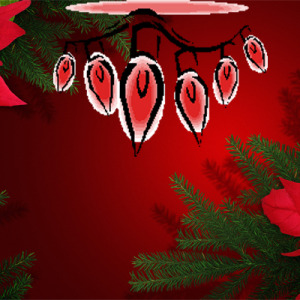 Many of us will soon be hanging Holiday lights; the season is upon us! Sometimes we get busy and forget to put safety first, here are a few do’s and don’ts:
Many of us will soon be hanging Holiday lights; the season is upon us! Sometimes we get busy and forget to put safety first, here are a few do’s and don’ts:
Do – throw away those old lights and replace them with LED. LED Holiday lights use a fraction of the energy, they are cool to the touch, they will outlast the old incandescent lights and they have great intense color.
Do – make sure the lights are rated for outdoor use when installing outdoors.
Do – use only outdoor rated extension cords.
Do – plug the lights into a ground fault circuit interrupter (GFCI) outlet or use extension cords with a GFCI on the cord.
Do – use plastic hooks instead of metal, staples or nails.
Do – tuck cords away out of the reach of children and small pets. Avoid running cords under carpets.
Don’t – connect too many strings of lights together. Be sure to read the manufacturer’s recommendations.
Don’t – plug one plug strip into another. Plugs strips are not approved to be joined together.
Don’t – leave the lights up over 90-days. Holiday lights are approved for temporary installations only.
Do – be safe and have a great Holiday Season!
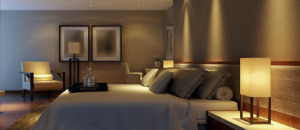 As summer time becomes a memory, our lives turn to more indoor activities. This typically means using more electric light sources, which lead us to evaluating if there is enough illumination in our living spaces. If you find your living space lacking appropriate light, don’t panic; this does not mean a complete lighting upgrade. Instead, break down the layers of light in your space into three categories: General Lighting, Task Lighting and Accent Lighting.
As summer time becomes a memory, our lives turn to more indoor activities. This typically means using more electric light sources, which lead us to evaluating if there is enough illumination in our living spaces. If you find your living space lacking appropriate light, don’t panic; this does not mean a complete lighting upgrade. Instead, break down the layers of light in your space into three categories: General Lighting, Task Lighting and Accent Lighting.
General Lighting, otherwise known as ambient lighting, provides a comfortable level of brightness for one to see and walk about safely. General lighting replaces sunlight and is fundamental to a lighting plan. Ceiling or wall mounted light fixtures, pendants and recessed downlights are typically what provides general lighting in the space.
Task Lighting helps one perform a specific task such as reading, cooking, homework, games and hobbies. Task lighting should be free of distracting glare and shadows and should be bright enough to prevent eyestrain. Portable lights, pendants or directional lighting fixtures can provide task lighting.
Accent Lighting adds drama to a room by creating visual interest. Highlighting artwork, prized possessions or wall textures draws the eye to these areas. Accent lighting requires at least three times as much light on the focal point as the general lighting around it. Adjustable track heads, recessed wall-washers or wall mounted light fixtures typically provide this type of lighting.
So when you feel your living space does not have enough light, remember that doesn’t mean an expensive lighting upgrade. Simply evaluate the layers of light in your space and improve the weakest layer. You will be happy with the end results.
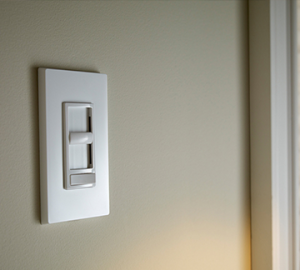 There are different dimmers for different light bulbs and systems. Most of the time the manufacturer will include this information in their literature; as a general rule-of-thumb:
There are different dimmers for different light bulbs and systems. Most of the time the manufacturer will include this information in their literature; as a general rule-of-thumb:
• incandescent and 120V halogen bulbs use standard incandescent dimmers
• low voltage bulbs use either an electronic or a magnetic low voltage dimmer; depending on the type of transformer used
• fluorescent lamps require both a dimming ballast and a fluorescent dimmer (note: some screw-in dimming bulbs can operate on an incandescent dimmer, be sure to follow the manufacturer’s instructions)
• be sure to check the dimming requirements of the LED driver in your application; requirements will differ between manufacturers, some are 120V, some 12V and some use 0-10V fluorescent dimmers. Not all LED drivers are dimmable.
Click here to read more about dimming…
Photo courtesy of Leviton Manufacturing
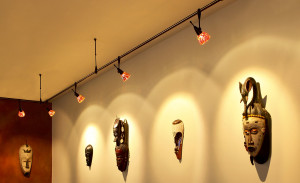 Low voltage light sources give you more choices, will save energy, will give more light and will last longer than their 120V incandescent counterparts.
Low voltage light sources give you more choices, will save energy, will give more light and will last longer than their 120V incandescent counterparts.
An incandescent A style bulb has no control; it gives light in all directions – a “blob” distribution. An incandescent PAR bulb has a parabolic aluminum reflector and can produce distributions from narrow spot to wide flood. A low voltage MR16 bulb can produce precise beam patterns allowing you to control and direct the light on the task plane.
Low voltage will give you more lumens per watt and produces a whiter brighter light than incandescent. Plus, they have a longer lamp life. Take a look at this comparison:
A 12V 50W bi-pin halogen bulb produces 1000 lumens with an average life of 2000 hours compared to a 120V 50W bi-pin halogen bulb which produces 700 lumens with an average life of 1500 hours.
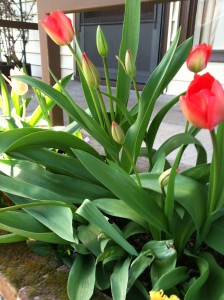 Don’t forget the controls for your new outdoor space. If switched from indoors, add a dimmer, this will save you money by using less electricity and will increase the life of your bulbs (that would be light bulbs, not tulips!).
Don’t forget the controls for your new outdoor space. If switched from indoors, add a dimmer, this will save you money by using less electricity and will increase the life of your bulbs (that would be light bulbs, not tulips!).
Low voltage systems require transformers and many are offered with time clocks, photocells or both. Many 120 volt fixtures also come with photocells (or can be added later) and your electrician can put them on a time clock so you can have control over the hours of operation.
Just like your garden, start small and watch it grow – you do not have to do it all at once.
 Lighting stairs and pathways is important for the security and safety of your guests. Especially important if the path is hard to navigate or has obstacles in the way. People feel safe and comfortable when they can see the area around them. Use lights that will evenly illuminate the space; patterns of light and dark can make it more difficult for some to navigate the path.
Lighting stairs and pathways is important for the security and safety of your guests. Especially important if the path is hard to navigate or has obstacles in the way. People feel safe and comfortable when they can see the area around them. Use lights that will evenly illuminate the space; patterns of light and dark can make it more difficult for some to navigate the path.
Landscape lighting is available in both low voltage and 120 volts. Low voltage can be easily installed by the homeowner, while 120 volt will require a qualified electrician to install.
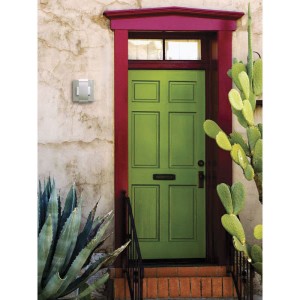 Often overlooked, outdoor lighting can add value to your property, increase safety and create an atmosphere that will give your guests that welcome feeling.
Often overlooked, outdoor lighting can add value to your property, increase safety and create an atmosphere that will give your guests that welcome feeling.
Creating an outdoor room is a perfect place to start. Already have the BBQ and a patio table? By simply adding a BBQ light or a portable lamp, you have already begun creating your outdoor living space.
Layering outdoor lighting, just like you would do in the interior, will create even more ambience to your space. Maybe add an outdoor fan, a pendant or a chandelier over your table and you will be able to enjoy your outdoor space well beyond sunset.
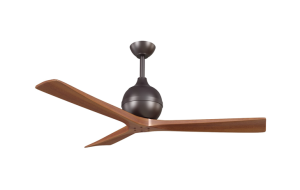 There are many brands of ceiling fans to choose from, find one that offers a style and a finish that you like. Most fan manufacturers offer several styles from traditional to modern contemporary, and many offer outdoor models. Keep in mind the scale of the fan for the room in which it will be installed.
There are many brands of ceiling fans to choose from, find one that offers a style and a finish that you like. Most fan manufacturers offer several styles from traditional to modern contemporary, and many offer outdoor models. Keep in mind the scale of the fan for the room in which it will be installed.
 Many of us will be hanging Holiday lights this weekend; the season is upon us! Sometimes we get busy and forget to put safety first, here are a few do’s and don’ts:
Many of us will be hanging Holiday lights this weekend; the season is upon us! Sometimes we get busy and forget to put safety first, here are a few do’s and don’ts:
Do – throw away those old lights and replace them with LED. LED Holiday lights use a fraction of the energy, they are cool to the touch, they will outlast the old incandescent lights and they have great intense color.
Do – make sure the lights are rated for outdoor use when installing outdoors.
Do – use only outdoor rated extension cords.
Do – plug the lights into a ground fault circuit interrupter (GFCI) outlet or use extension cords with a GFCI on the cord.
Do – use plastic hooks instead of metal, staples or nails.
Do – tuck cords away out of the reach of children and small pets. Avoid running cords under carpets.
Don’t – connect too many strings of lights together. Be sure to read the manufacturer’s recommendations.
Don’t – plug one plug strip into another. Plugs strips are not approved to be joined together.
Don’t – leave the lights up over 90-days. Holiday lights are approved for temporary installations only.
Do – Have a wonderful and safe Holiday season!
Complete List
 A Repeat Broadcast Posted on March 9th, 2017
A Repeat Broadcast Posted on March 9th, 2017
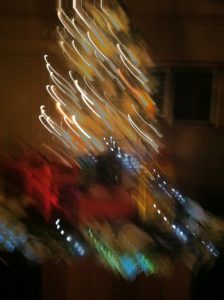 Holiday Lights Posted on November 16th, 2016
Holiday Lights Posted on November 16th, 2016
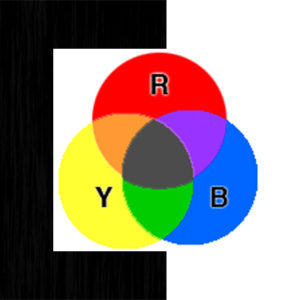 Black or White? Posted on November 3rd, 2016
Black or White? Posted on November 3rd, 2016
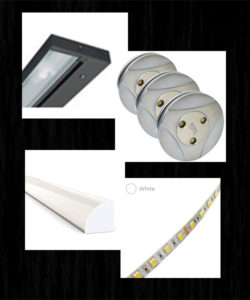 Under Cabinet Lighting Posted on October 14th, 2016
Under Cabinet Lighting Posted on October 14th, 2016
 Be Proactive! Posted on September 21st, 2016
Be Proactive! Posted on September 21st, 2016
Categories
 New (number of posts: 3)
New (number of posts: 3) Tips (number of posts: 41)
Tips (number of posts: 41) Uncategorized (number of posts: 10)
Uncategorized (number of posts: 10)